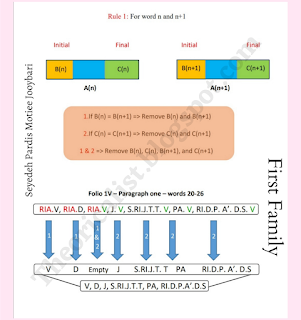Voynich Manuscript: Fungi and Ants
Folio85r1 - Paragraph 8 - Part 1:
P'.D.S.A.M, J, V.P'.A', V.P'.A'.S.V, K.P'.T', S.A, RI.T.J.D, S.A'.S.A, A'.D
P'.D.S.A.M, J, S.V, K.P'.T', S.A, RI.T.J.D, S.A'.S.A, A'.D
بدسام ج سو کپت سا ریتجد ساسا اد
ب دسامج سوکپت ساری تج دساسا اد
به دسامه شوکفت سری تاج دساسه اد
به دسمه شکفت سرتاج دساسه
Be dasama shekoft sartaaj e dasaasa
Dasama (دسمه) means ant and aj (ج - ) is a suffix which can be seen in a few words. For example the word dasta (دسته) had changed to dastaj (دستج) in old times, resulting of Arabic effects on the Persian word.
Shokoft (شُکُفت) can be a vowel shift in the dialect variety for shekoft (شِکُفت). however, I have not seen this type yet. On the other hand, bloom in noun form would be shokofeh (شُکوفه) .
Shekoftan (شکفتن) is a verb infinitive which means "to bloom", and Shekoft (شکفت) is third person singular of the verb. It is in the past tense.
Sar means head and taj/taaj equals to crown.
Sartaaj itself is a word.
Together it is like:
Into the ant, the head - crown of mushroom bloomed.
S. P. Motiee Jooybari




Comments
Post a Comment